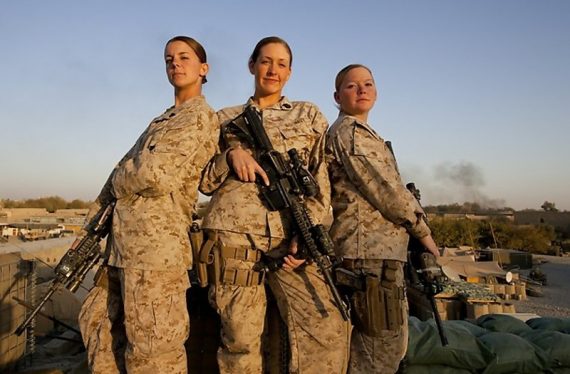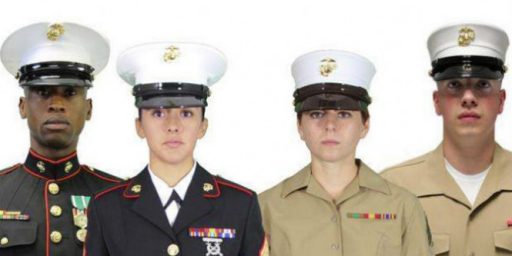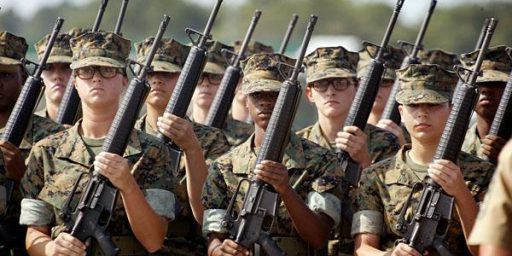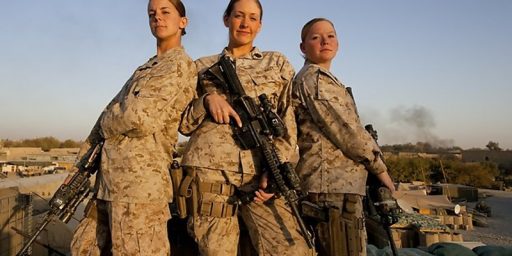Women to Attend Marine Infantry School
Some Marine women are going to Infantry Officers Course. Here's how to make it work.
The Marine Corps is going to send women to its Infantry Officers Course.
Marine Corps Times (“USMC 4-star: Women to attend infantry school“):
As part of the service’s extensive research campaign to determine what additional jobs could be opened to women, an undetermined number of volunteers will attend the Infantry Officers Course in Quantico, Va., said Gen. Joseph Dunford, the Corps’ assistant commandant. There, Marine officers are groomed to serve in direct combat roles and lead troops into battle.
“We are in the process right now of soliciting volunteers,” Dunford said on Wednesday.
It’s a monumental — if controversial — move for the Marine Corps, which until now barred female Marines from the program and required instead that they attend other courses aimed at preparing them for assignments in support roles such as logistics, personnel administration and aircraft maintenance, among others.
Soon, enlisted women also will have an opportunity to attend infantry training, Dunford said. Marine officials are developing plans to assign female Marines to the Corps’ Infantry Training Battalions, which fall under the Schools of the Infantry.
Officials don’t yet know how many women — officer or enlisted — will be put into the academic pipeline for the Corps’ “03” infantry occupational code, Dunford said. All will be volunteers — and it remains to be seen how many will answer the call, he said.
It’s not immediately clear either what the next steps will be for those women who successfully complete the Corps’ infantry training programs. Marine officials at Quantico, who have led the service’s effort to explore lifting restrictions on women in combat, said these details are finalized, but declined to discuss them pending an official unveiling in the coming days.
[…]
The Corps has been studying this issue for more than a year. In February, officials announced that company-grade officers and staff noncommissioned officers would be assigned for the first time to select jobs previously open only to men, though not in the infantry or any billets for which ground combat is a primary mission. Starting in May, women will be considered for about 400 positions within six types of battalions:
• Amphibious assault
• Artillery
• Combat assault
• Combat engineer
• Low-altitude air defense
• Tank.
Additionally, new functional fitness tests are being developed to help Marine Corps leaders determine how women and men perform in, and cope with, various combat tasks. The goal is to establish “gender-neutral” physical fitness standards. Details are scant, but the Marine Corps’ Training and Education Command is looking to purchase a variety of new equipment specifically for these tests, suggesting the tasks associated with them will closely mimic combat-essential duties such as operating and moving heavy weaponry, and carrying casualties from the battlefield.
The Marine Corps defines gender-neutral physical standards as being identical for men and women, rather than weighted — or “gender-normed” — like those applied in the service’s annual Physical Fitness Test. During the PFT, women can earn a minimum or maximum score with fewer repetitions and a slower run times than their male counterparts.
This suggests that women wanting to serve in ground combat units will be given the shot to do so only if they can keep pace with their male counterparts. Standards would likely evaluate Marines not as women and men, but simply as infantrymen, tank crewmen or artillerymen, for example.
I’m reminded of an exchange from the 1987 Nick Nolte flick “Extreme Prejudice” in which Nolte’s character was asked about an impending move to allow women to serve as Texas Rangers. He replied, “Hell, I don’t care, as long as she’s 6’6″, mean as a snake.”
Historically, the US military has opened positions to women in the worst possible way: by lowering the standards, ensuring they would have a difficult time getting the respect of the men with whom they’re serving. At everything from basic training to jump school to fighter pilot training, they either segregate women into separate classes or treat them differently by expecting less. There’s a requirement to do 12 pull-ups to pass the course. Can’t do 12 pull-ups? Can’t do any pull-ups?! Well, don’t worry about it, honey. Just hang there on the bar like a dead possum for a few seconds and we’ll call it even.
Back in the dark ages when I was an ROTC cadet, the Army dumped the old Army Physical Readiness Test and replaced it with the Army Physical Fitness Test. It still consisted of the same three events–pushups, situps, and a 2-mile run–but the standards on each went up radically. It went from a test in which an average soldier could show up and pass it and a fit one could easily max it without additional training to one in which only athletes were able to max it and most soldiers would require constant training to pass. (The test standards were subsequently ratcheted down significantly and recently replaced with an entirely different set of tested items.)
Male and female soldiers took the same test but were graded on completely different standards. Female cadets in their physical prime were held to roughly the same expectations as 39-year-old men. Female cadets who were routinely falling out of our formation runs because they were worthless and weak were easily passing their PT test while males who were hanging tough actually received lower scores. The upshot was that the males simply didn’t regard the females as real soldiers, much less peers.
It sounds like the Marine Corps has learned this lesson and intends to hold male and female Marines to the same standard. If they do this–and that means failing out women who can’t cut the mustard–women who graduate the Infantry School will be considered bona fide.
A related lesson from past attempts to integrate women into everything from the service academies to flight training is that a critical mass is needed. You simply can’t have one or two women in a class, because then they have no support system and, more importantly, can’t be allowed to fail. Bring in enough women to constitute, say, ten percent of the class. That way, none of them are isolated or bear the burden of representing their gender.







Wise words, Mr. Joyner. I share your oberservations on the Army PT tests. Demi Moore also made this point in “G.I. Jane”, refusing to accept the lowered standards in her training.
There’s a much simpler way to make it work:
Tell the Marines, “make it work.”
Then step back and watch as they make it work.
‘Cuz that’s how Marines are. Ask their opinion, get an earful. Give them an order, it’ll get done. Regardless of their personal feelings. Remember how they were the loudest against allowing gays in the service? The day after that went away, a recruiter went down to a gay social center.
Yeah, I remember that from my AF Field Training. Women could get 50 points by doing one pull-up. Ticked me off. Either the physical standards mean something in the real world or they don’t. If you can play political games with them, then they don’t.
I’m glad the Marines are going this way. It’s important that the females earn that respect “up front” (just like the males); that means they don’t have to earn it “the hard way” — in their unit, with the cards stacked against them.
Makes sense to me.
I think there are women who can physically and mentally keep up with the men. But I remember reading about the effects on moral in the Israeli army when units take female casualties.
Now, the studies were done in the early 50’s, based on combat in ’49. Could it just have been a different time…and the fact that the Israeli soldiers then weren’t as well trained as most nations (including Israeli) soldiers today?
As an added thought, I recently watched the National Geographic series Carrier, where they filmed the lives of some of the crew of the Nimitz. The filming was done on her way to, during, and coming home from a tour of the Persian Gulf. I once believed women on ships, especially big ones, was not a big deal. This series changed my mind. I really wonder if we’re being told the truth about the disruption that having women on a ship is actually causing. I am willing to recognize, though, that all of the drama from the series could have been blown out of proportion by Nat Geo film crew.
James…any thoughts on the effect of women in combat/close quarters on moral?
Ugh…morale…not moral(s)…
There are plenty of jobs in the military that require a general, overall level of fitness. I have no problem tweaking those standards for women. I was a comm guy – nobody ever needed to be able to do 12 pullups to do my job. But there are other jobs that do require a specific physical capability – if you’re in artillery, say, and a shell or a bag of powder weighs X pounds, you have to be able to lift X pounds and carry it around. Period. If you can’t, you can’t have that job, gender be damned. As a corollary, I don’t think women should be barred from _competing_; I’m sure there are women who can do _any_ job the military has, and I’d have no problem serving alongside them. But some standards are more flexible than others.
In some branches, the PFT requirements are reduced based on the age of the recruit/soldier as well. Really, they need to study what the actual physical requirements of the jobs are.
If you absolutely must be able to carry 70 lbs for 4 hours uphill without a break, how does that translate to pullups? Of course the standards for pullups can be reduced based on whatever the physical limitations of the person being tested are. Because pullups don’t accurately represent the requirements of the job in many cases.
For years people have lamented that women are getting out easier in the physical fitness tests, rather than complaining that the tests are meaningless. Fix the tests, don’t denigrate female soldiers who are doing their jobs just fine regardless of scoring. One standard for each job (or group of jobs), applicable to everyone, that accurately representing the needs of that job. Otherwise, you might as well measure everyone’s junk and call it a day. Much cheaper.
@yorick:
Probably not too closely–pull-ups would correlate to climbing (say into a high window), I’d think.
My neighbor is a Major in the USMC Reserve and he tells me the Marines are modifying their fitness assessment to correlate more directly to the kinds of work performed in combat. So they’re doing things like carrying weighted ammo cans over distances, hauling their buddies around in a fireman’s carry, and so on. It’s very similar to the link James put up to the Army’s revised PT test.
I think any woman who can meet the high standard required of a given military job should have the opportunity to fill it. I’ve no doubt any woman who could get through BUD/S would have no trouble kicking the asses of 99.9% of men in the human race…
I’ve definitely met female Marines who I would have no problem serving with. There were also plenty of terrible guys in my infantry company who I was scared to deploy with. If you can hack, you can hack it, period.
@Mikey:
FWIW, that was part of the PT test when I was in (now over 50 years ago) — carry the dude 100 yards in X seconds. We didn’t haul ammo cans around, though. We had to run 2 miles in full gear with rifle ( = M1) in under X minutes; climb a rope in full gear in under X minutes. I know there was more, but I can’t dredge it up. There may have been pull-ups involved.
Heh. I remember the runs. No matter how tight I cinched my pisspot down, the effing thing kept banging me in bridge of the nose. Made my eyes water. If the guys I was running with hadn’t kept pulling me back on the course, I’d probably have run out into the boonies by my lonesome.
If they do this–and that means failing out women who can’t cut the mustard–women who graduate the Infantry School will be considered bona fide.
That’s honestly all I’ve ever asked. My big problem with women in virtually any position in the military is that they historically either can’t cut it or don’t have intentions on cutting it, creating a system of affirmative action. Commanders, of course, adjusted – in the Navy, most of the women you see during GQ are operating JL phones – but for every one that was worth anything in my rating (Machinist’s Mate), there were five more who were crap. My feelings on women when I served was that they were good for two things: something to hump while out to sea (I was on a carrier), and someone to do our paperwork. Looking back, I’m ashamed to say that’s closer to the truth than I’d like to admit.
If a woman can handle herself with the men, then great, I’d want her serving alongside me, and I’d respect an officer above me that did that. Otherwise, they’re just tools for civilian politicians.
I spoke to a retired Marine field-grade infantry officer (combat tours in Iraq) who said it was clear to him that this is simply a preemptive move by the USMC to prove that truly “gender neutral” standards for direct combat service rule out women’s participation.
I come from a military family-
However, I’ve always had mixed feelings concerning this matter, until a couple of weeks ago inwhich I read an article that tipped the scales-
It opened my eyes to something that I had not really thought about before and I must say that I would not want not one of my daughters choosing this route.
http://www.newswithviews.com/Emord/jonathan240.htm
Standby for failure and unforeseen repercussions. Infantry Soldiers and Marines are the essence of the fighting force. Most Special Operations Soldiers are raised in these ranks and the infusion of women, while sounding good in a briefing will assuredly fail on the ground. I assure you this will result in a fall in morale and standards. Call me what you will but men and women are different.